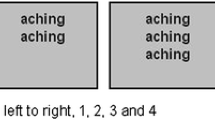Abstract
Investigations of pain using functional imaging techniques have revealed an extensive central network associated with nociception. This network includes the thalamus, insula, prefrontal cortex and anterior cingulate cortex (ACC) as well as the somatosensory cortices. Positron emission tomography (PET) of regional cerebral blood flow (rCBF) has demonstrated activation of the ACC during cognitively challenging tasks such as the Stroop interference task and divided attention. One interpretation of this research is that ACC is involved in the general features of attention and that it does not play a specific role in pain processing per se. Three-dimensional PET imaging provides a method for assessments of rCBF in a single individual during multiple tasks. In addition, coregistration of PET and magnetic resonance (MR) images allows for better localisation of the PET signals so that differences in cortical activation sites can be more accurately determined. This approach was used to assess rCBF during the experience of pain by subtracting images collected during heat from those during noxious heat stimulation. Two regions of the ACC had elevated rCBF, one in the perigenual region and one in the mid-rostrocaudal region (i.e. midcingulate cortex). During the execution of the Stroop task, the group result showed the midcingulate region overlapping with the site seen during the experience of pain. This group result, however, was not confirmed in the individual subject analysis, which revealed widespread and independent areas of ACC response to pain and Stroop. It is concluded that the ACC contributes to multiple cognitive procedures. It is inadequate to describe the primary contribution of ACC to pain processing as “attention” because it is unlikely that the multiple small and independent activation sites produced by pain and Stroop subserve attentive processing throughout the brain.
Similar content being viewed by others
Author information
Authors and Affiliations
Additional information
Received: 22 July 1996 / Accepted: 28 May 1997
Rights and permissions
About this article
Cite this article
Derbyshire, S., Vogt, B. & Jones, A. Pain and Stroop interference tasks activate separate processing modules in anterior cingulate cortex. Exp Brain Res 118, 52–60 (1998). https://doi.org/10.1007/s002210050254
Issue Date:
DOI: https://doi.org/10.1007/s002210050254




